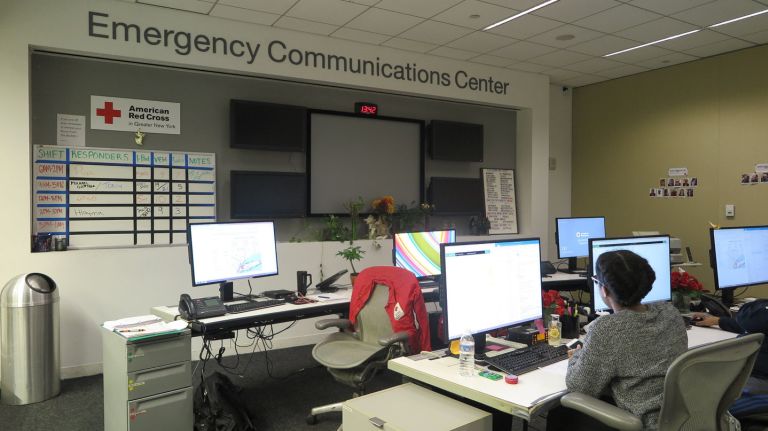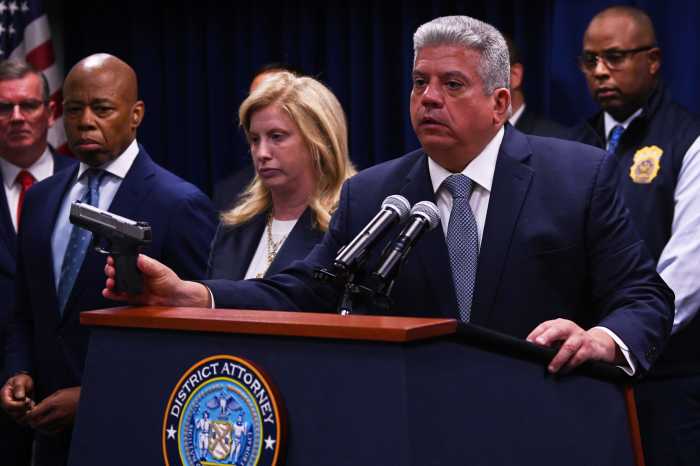
In recent weeks, Red Cross responder Hlayma Shilleh, 33, has been to dozens of fires, including the fatal blaze in the Bronx. Some days have seen three or four back-to-back, she said, many caused by boilers, gas and electrical appliances.
“Extreme weather coincides with fires,” which are the most common emergency the organization responds to, said Michael de Vulpillieres, a spokesman for the Red Cross Greater New York Region, covering New York City, Long Island and the lower Hudson Valley.
With temperatures below freezing every day since Christmas, the Red Cross has responded to 150 disasters in or around the city and assisted more than 660 people, de Vulpillieres said. That’s about 50 more incidents during the same time period last year, with a total of 390 individuals helped.
The process of responding to disasters begins at the local Red Cross headquarters in Hell’s Kitchen. The long brick building on 49th Street, between 10th and 11th avenues, houses its Emergency Communications Center, or what de Vulpillieres calls “the nerve center.” The classroom-like space is where dispatchers first learn of emergencies, from the region’s offices of emergency management, the FDNY and the Breaking News Network.
Dispatchers, surrounded by a half-dozen monitors and five TV screens, continually man the phones, taking and making calls in order to organize the response needed for a given emergency.
“There’s a team at the ready all the time. We’re a 24-hour operation,” de Vulpillieres said.
The night of the fatal Bronx blaze that killed 13 people and displaced about 25 families in Belmont on Dec. 28 was especially busy for the two dispatchers on duty.
“From 7 p.m. until well past 9 there was never a time when one or the other of us weren’t on the phone,” volunteer Gordon Williams wrote in a blog post on the Red Cross website. In addition to the fatal fire, there were four other blazes around the city at the same time, he said.
As the dispatchers monitor disasters, at least two responders arrive at the scene, where residents are often waiting.
“Our goal is to get out there and respond immediately and be there as it’s going on and have someone for them to turn to,” said Michael Gunther, 51, another one of the chapter’s more than 6,000 volunteers.
The first priority is determining the needs of the people affected, who are often disoriented and upset, said Shilleh, who’s been with the Red Cross for seven months. “We try to calm them down. We try to comfort them.”
With larger fires, the responders bring an Emergency Response Vehicle, or a large box truck stocked with blankets, snacks and other supplies. They get everyone affected to a safe place, such as a school or an MTA bus, which is made available with the help of the Office of Emergency Management.
At the Belmont fire, the Crotona International High School served as the first meeting location. The next day, the Red Cross had an MTA bus set up less than a block from the Prospect Avenue building where the blaze started.
Once a safe location is established, the registration process begins, so the Red Cross can determine what victims need and provide them with prepaid debit cards and/or secure temporary housing. The nonprofit has partnerships with several hotels across the city, which translates to emergency housing for typically at least two nights. After that, impacted individuals meet with a case worker, and the city’s Department of Housing Preservation and Development assists them with more long-term shelter.
For people who have lost loved ones in disasters, the Red Cross connects them with trained mental health workers as well, de Vulpillieres said.
Helping people cope with losing a relative, especially a child, is the most challenging part of the job, Shilleh said. She had to grapple with that challenge at the Belmont fire, which killed four children.
“That moment on scene when they know that their kids are gone, that’s the most challenging part ever,” she said. “How do you comfort them?
“We always tell them, whenever you want to talk, we’re always here.”




































